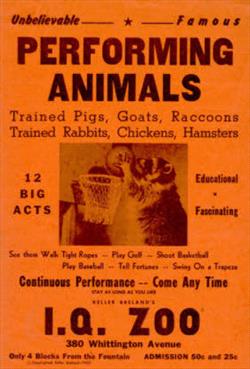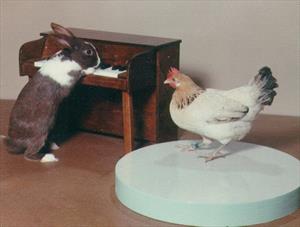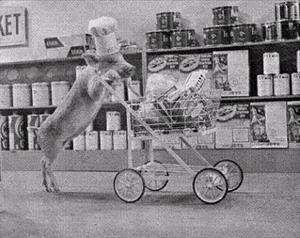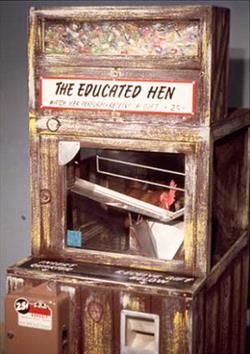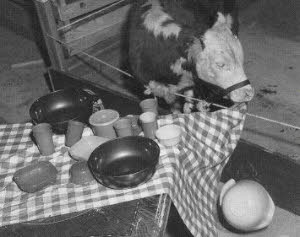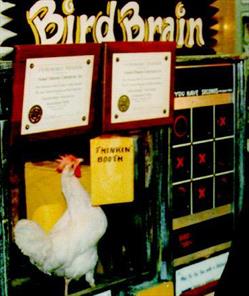In the early 1900s, B.F. Skinner was working out the technology of operant conditioning. He wrote a landmark book called The Behavior of Organisms that described the parameters for the field of Behavior Analysis. His studies on rats and pigeons changed how we view learning in animals today. But it was two of his graduate students, Keller and Marian Breland, who applied that research to widespread practical use. In 1947, they started a hugely successful business called Animal Behavior Enterprises, with the goal of demonstrating that there’s a better, scientific, technological way of training animals and it need not use punishment. Their effort was to train animals in a humane way with less aversives. By taking concepts and principles learned from the lab, they were able to mass produce trained animals and to “outstrip old-time professional animal trainers in speed and economy.” Over the course of 47 years, ABE trained over 15,000 animals and 140 species for the military, TV, trade shows, conference, research, and for their theme park, IQ Zoo, which they opened to showcase their trained animals. Four years after inception they published their findings in American Psychologist. In just a short period of time, they had developed the field of Applied Animal Psychology or behavioral engineering. Here is that first landmark paper. You can also find this paper reprinted in the appendix of How to Behave So Your Dog Behaves.
A Field of Applied Animal Psychology
Amer. Psychologist, 1951, 6, 202–204.
Keller and Marian Breland, Lonsdale, Arkansas
Recent developments in behavior theory have made possible a new field of applied psychology. This new field has yet to be finally christened. It might be called the field of applied animal psychology or the field of behavioral engineering. We consider it an excellent example of how the findings of “pure” research can be put to practical use.
The core of the field is the work of the neobehaviorists, which has so ordered the facts of behavior that many of their experimental data and those of earlier workers have become immediately applicable to the engineering of animal behavior. We have found most useful the systematic formulation presented by B. F. Skinner in The Behavior of Organisms. This body of theory has made it possible for us since the spring of 1947 to develop a flourishing and expanding business concerned with the mass production of conditioned operant behavior in animals.
Applied animal psychology brings together the two formerly unrelated fields of professional animal training and modern behavioral science. The field is new in that it represents, we believe, the first application of systematic behavior theory to the control of animal behavior. We are now in a position to outstrip old-time professional animal trainers in speed and economy of training. In many instances, we can use automatic training methods. We can apply to our training the data of comparative psychology, utilizing new tricks, new animals. We can turn out multiple units – 200 “Clever Hanses” instead of one. Furthermore, the systematic nature of the theory puts us in a position to advance to new and more elaborate behavior patterns, predict results, and forestall difficulties.
So far, all our applications have been made for the purpose of advertising exhibits for General Mills, Inc. We developed first a series of trained chicken acts, which were used for county fair booth exhibits in the Midwest, for the purpose of advertising farm feeds. These acts were performed by a group of two-year-old hens, which had been culled from a neighbor’s flock and were destined for the stew pot. We used a hen-sized stage, some specially constructed props, and a solenoid-driven automatic feed hopper for dispensing reinforcements in the form of scratch grain.
One hen played a 5-note tune on a small piano, another performed a “tap dance” in costume and shoes, while a third “laid” wooden eggs from a nest box; the eggs rolled down a trough into a basket – the audience could call out any number of eggs desired, up to eight, and the hen would lay that number, non-stop.
The basic operation in all these acts was reinforcement at the proper moment in the behavior sequence, by presenting the chicken with a small amount of scratch grain from the solenoid-operated hopper. During the training period, successive approximations to the desired behavior, and component parts of the final pattern, were reinforced. During performances, longer ratios or more elaborate completed patterns were reinforced to keep the behavior at a high level of strength.
During the ensuing year, three sets of these acts were prepared and shipped all over the United States in the hands of men who had had only once or two days’ training. The birds played thousands of performances without a single failure, except for an occasional sluggish performance due to ill health or overfeeding. The acts proved to be unprecedented crowd-stoppers at the fairs and feed-store “Openhouse” events where they played, showing to as many as 5,000 people in a day.
The success of these acts led to the development of a trained pig show, “Priscilla the Fastidious Pig,” whose routine included turning on the radio, eating breakfast at a table, picking up the dirty clothes and putting them in a hamper, running the vacuum cleaner around, picking out her favorite feed from those of her competitors, and taking part in a quiz program, answering “Yes” and “No” to the questions put by the audience, by lighting up the appropriate signs.
Priscilla was likewise shown at fairs and special feed-store events and conventions throughout the country. She also appeared on television. She was even more successful than the chicken acts at jamming fair booths and feed-stores with spectators. The pig act was in use almost steadily from the fall of 1948 to the summer of 1950. It was necessary to train a replacement about every 3 to 5 month, since the pigs rapidly became too large for easy shipping. After training, the pigs were turned over to their handler, usually a General Mills’ feed salesman, who had had one or two days’ instruction at our farm, or in the field under our supervision.
In addition to teaching handlers to manage the animals on the road, we have twice taught instructors to do the basic training of the animals and assist with the instruction of the handlers. Both experiences in training instructors were successful and demonstrated clearly that people with no special psychological background can learn the methods and theory behind our animal training procedures. One instructor was a woman college graduate who had taken her degree in statistics and sociology. The other was an average male high school graduate, whose only specialty had been radio repair work. Both acquired in a few weeks most of the techniques of training the existing acts, and enough of the theory and nature of the process to train new acts on their own.
Our next development was a baby chick act. Sixty to 100 chicks are trained for one show. Beginning at about one week of age, they are trained for about 10 days. The show is run with about 10 or 12 chicks on stage. Each runs up a ramp or inclined plane to a platform from which he can reach a feed hopper. He “roots” the top chick off, grabs a bite of feed, then in turn gets pushed off by the next in line. As he goes, he falls onto a tilting pan and is deposited onto the stage floor, accompanied by the sounding of a chime and flashing of a trade name sign. This sequence of behavior results in an endless chain of baby chicks running up the ramp and sliding off. When the group becomes sleepy, they are replaced by a fresh batch, and the show can thus go on indefinitely; it has actually been used about 12 hours a day in most cases.
This act is our first “packaged act.” It is designed to run virtually automatically. It requires only the attendant to keep the feed hopper full and change the group of chicks on stage when they become sleepy. No special training is required for the attendant; mimeographed directions are shipped out with the chicks and provide the only necessary instruction. This act has been a perennial favorite and we have trained more than 2,500 chicks to fill our orders for this display.
We have developed two variations on the baby chick act. One uses a projector to present advertising copy, which an endless chain of baby chicks in motion around it. The other variation substitutes for the ramp a series of steps onto which the chicks must jump.
A calf was trained for the General Mills’ booth at the International Dairy Exposition at Indianapolis. “Larro Larry” took part in a quiz program by lighting up “Yes” and “No” signs, as did Priscilla the Pig, and played “Bull in the China Shop” by systematically upsetting an elaborate display of dishes, to the great alarm of the passing crowd.
A turkey act has been developed in which members of the audience play a game with the turkey. This bird is placed in a display case and has access through an opening to part of the miniature playing field. The turkey is trained to rake a steel ball off this field into his goal. The audience player is given a long pole with a magnet on the end and tries to guide the ball along the playing field into his goal before the turkey wins. Various barriers are placed along the playing field to make the game more difficult for both players.
Additional acts using grown chickens have been designed and used, two involving discrimination problems: the Card Sharp, who picks out a better poker hand than a member of the audience; and the Old Shell Game, in which the chicken picks out the shell with the bean under it; and two contests between two birds, a High Jump contest, and a Strength of Pull test. Another automatic act was created by training a hen, on a very high fixed ratio, to beat a toy drum for hours at a time. We also trained a hen in some bizarre contortions; the hen twisted her neck to one side and over her back so that she appeared to be looking frantically in all directions at once. This was billed as “The Civilian Aircraft Spotter” or “The Atom Bomb Neurosis.” We have done a few experiments and some developmental work on rats, hamsters, guinea pigs, ducks, pigeons, rabbits, cats, dogs, and crows.
(Clip from Patient Like The Chipmunks, a documentary about Animal Behavior Enterprises, whose goal was to demonstrate that there’s a better, scientific, technological way of training animals and it need not use punishment. And by taking concepts and principles learned from the lab, they were able to mass produce trained animals. This clip shows animals who were trained for test commercials and eventually used for real commercials. To purchase the full, narrated version of this incredible DVD, go to http://www.behavior1.com/page7.html. For more information on ABE, visit http://www3.uca.edu/iqzoo/iqzoo.htm).
There are, obviously, innumerable other possibilities in the field of advertising exhibits. One is the perfection of the “packaged act,” the fully automatic unit that can be shipped anywhere, set up in a store window or convention booth, and operated day in and day out with no more instruction than are necessary for the operation of any machine designed for such use. One adaptation of the automatic act is the animated display – show window advertising in which live animals take the place of puppets and robots.
(Clip from Patient Like The Chipmunks, a documentary about Animal Behavior Enterprises, whose goal was to demonstrate that there’s a better, scientific, technological way of training animals and it need not use punishment. And by taking concepts and principles learned from the lab, they were able to mass-produce trained animals. This clip shows the mechanized animal shows that were popular at fairs and parks across the country. To purchase the full, narrated version of this incredible DVD, go to http://www.behavior1.com/page7.html. For more information on ABE, visit http://www3.uca.edu/iqzoo/iqzoo.htm).
However, probably the biggest applications exist in the entertainment world. Here we can take over the formal animal training involved in the standard animal act for stage, circus, and movies, and do it faster, cheaper, better, and in multiple units. It is possible to create new acts, whole new circuses, and in fact, using unusual animals and unusual acts, and again do it cheaply, quickly, and in numbers limited only by time and production facilities. Television offers unusual opportunities. We can invade the field of nightclub entertainment with novel small animals. We can sell or rent trained animal units to hospitals, doctors’ offices, waiting rooms of various sorts, or even to private individuals, supplying instructions on care and maintenance.
Another important application of animal psychology is the training of farm animals. Farm dogs and horses could be rendered much more useful to the average farmer if they were given appropriate training. Farmers could themselves be instructed in training and handling their own animals.
The training of dogs for the blind could probably be done on a larger scale, more rapidly and efficiently. One of the big problems of the “Seeing Eye” institution was obtaining instructions. The difficulty was, apparently, that the first masters of the art did not have a sufficiently precise theoretical formulation in training the dogs and hence could not pass the information on to new instructors. They then encountered another problem in instructing the blind to handle the dogs and met numerous failures here in adapting client to dog. Many of these failures could now doubtless be avoided.
Dogs, of course, can be trained more readily with the new methods in all the traditional fields of canine service to mankind: hunting, guarding children and property, and detective work. Military use of dogs in such tasks as guard duty and carrying messages can also be made more effective.
This, then, seems to be the general outline of a promising new field that we have only begun to explore. It is so vast, we feel, that we cannot begin to develop one-tenth of the projects we have thought of. More psychologists, grounded in the theory, are needed to advance the technology and explore the undeveloped portions of this program. Furthermore, once the technology gets underway and the business develops, there will be active need for academic psychologists to do the background research necessary for full development of the program. And, of course, as psychologists continue to do basic research using animals as subjects, one by-product will be new and better methods of applied animal psychology.
Two types of problems have cropped up repeatedly in our efforts. (1) Apparatus problems have consumed much more time than problems connected with the behavior. The apparatus must be durable enough to stand up under cross-country shipment, and must be foolproof enough to be operated by relatively untrained personnel. (2) We need to know the answers to various “academic” problems, such as “What sort of fixed ratio will an animal sustain on a response made to a disappearing manipulandum, a key available, for example, only every three minutes?” “What would constitute an adequate reinforcement for a hamster, to sustain performances over several hours without satiation?” “What are the emotional characteristics of rabbits and guinea pigs – to what sort and magnitude of stimuli will they adapt, and what is the nature of the curve of recovery from such an adaptation?”
The study of these and related questions – in short, the re-examination of the whole field of comparative psychology in this new light – by psychologists who have available the facilities of an animal laboratory, would greatly speed up the development of the applied field.
In conclusion, we feel that there is a genuine field of applied psychology, old as “group living” and “parenthood” in its subject matter, but new in method and approach, which psychologists can enter with promise of financial reward and a sense of accomplishment and ultimate benefit to the science. For all, we know that there is nothing as convincing to the layman of the worth of a discipline as achievement, and the present field offers the psychologist a fine opportunity to demonstrate control of his subject matter.
For more information about the Brelands, ABE, and IQ Zoo, visit:


